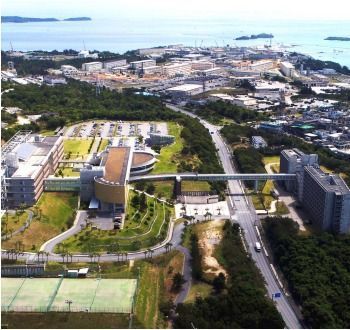Civilian and U.S. military buildings surrounding Henoko base exceed civil aeronautics and U.S. military height restrictions

April 9 photograph of the National Institute of Technology, Okinawa College in the foreground, and Camp Schwab in the center rear (photograph taken via small drone)
April 13, 2018 Ryukyu Shimpo
If construction of the replacement facility for Futenma Air Station in Henoko, Nago City is completed, some structures in Toyohara Ward and the Henoko Ordnance Ammunition Depot in Camp Schwab will surpass the height restrictions set by the U.S. military for safety purposes.
Also, should Japan’s civil aeronautics law apply to the replacement facility in Henoko, buildings will have to be limited to 45 meters in height within a radius of 3000 meters from a point of reference on the runway.
One after another, residential buildings and public facilities within this range that exceed the civil aeronautics law limitations have been identified.
The construction of the Futenma replacement facility is proceeding in a way that it will not comply with U.S. military standards, or standards set forth in Japan’s civil aeronautics law.
In an interview with the Ryukyu Shimpo, an official of the Okinawa Defense Bureau acknowledged that the Henoko Ordnance Ammunition Depot surpasses the 55-meter height restriction, and said, “We are coordinating with the U.S. for height restriction exceptions to be made.”
However, under the Act on Special Provisions of the Civil Aeronautics Act of the U.S.-Japan Status of Forces Agreement, U.S. military activity is exempt from civil aeronautics law safety regulations.
By making exemptions to regulations established for the purpose of safety by the U.S. and Japan, they become regulations in name only.
The U.S. Unified Facilities Criteria are becoming an issue in that they restrict the height of buildings constructed within 2286 meters of a runway.
Should the Henoko base be completed, there cannot be buildings exceeding approximately 55.7 meters.
In Toyohara Ward there are buildings that potentially breach these criteria on building height. These inlcude buildings around 57 to 60 meters tall in the vicinity of Kube Post Office and the Northern Okinawa Employment Capacity Development Coordination Center, and even public facilities and community sites about 50 meters tall.
In addition to this, since the Henoko Ordnance Ammunition Depot stores explosive materials, not adhering to height limitations meant to ensure safe aviation near the depot will likely spread concern in terms of the safety of the replacement facility.
It is already understood that National Institute of Technology, Okinawa College (NIT-Ok) buildings, Okinawa Electric Power Company utility poles, and telecommunication companies’ utility poles exceed the height restriction of approximately 55.7 meters.
In regard to this, an official of the ODB stated, “Except for Okinawa Electric’s utility po]les and telecommunication companies’ utility poles, we have assessed that even areas exceeding the height restriction of 55 meters will not impede the operation of aircraft, so exceptions to the height limit will be made.”
On April 11, the ODB made calls to NIT-Ok, Toyohara Ward, and Henoko Ward, among others, to explain measures being taken to make exceptions to building height restrictions.
(English translation by T&CT and Erin Jones)
Previous Article:OCVB to host committee aimed at adding Ryukyu cuisine and awamori to UNESCO’s list of intangible heritage list
Next Article:University of the Ryukyus joins the Millennium Seed Bank Partnership, teaming up with British researchers to conserve Yambaru trees for the future
[Similar Articles]
- The U.S. and Japanese governments agree on facilities improvement at Camp Schwab
- Reconstruction work of Henoko ammunition storage facilities continues
- Ten thousand people encircle Japan’s National Diet to protest land reclamation work in Henoko
- Governor Tamaki clarifies that the part of land reclamation announced as completed is only partially completed
- US military sets up restricted area on beach to keep people away from Osprey wreckage
 Webcam(Kokusai Street)
Webcam(Kokusai Street)


